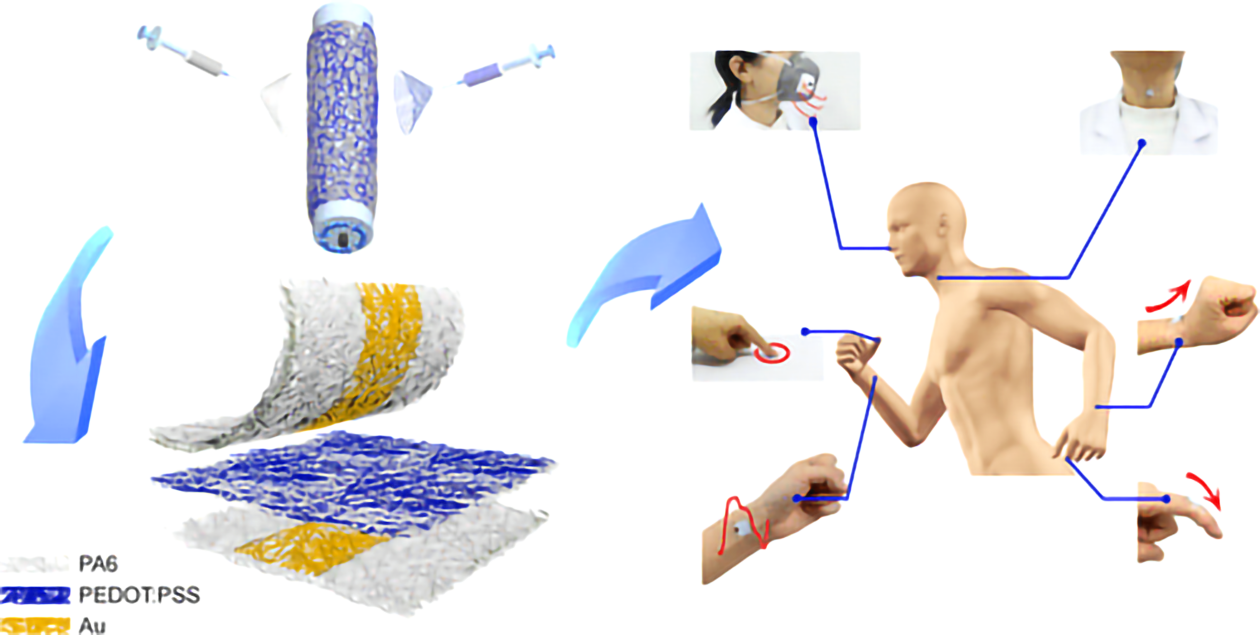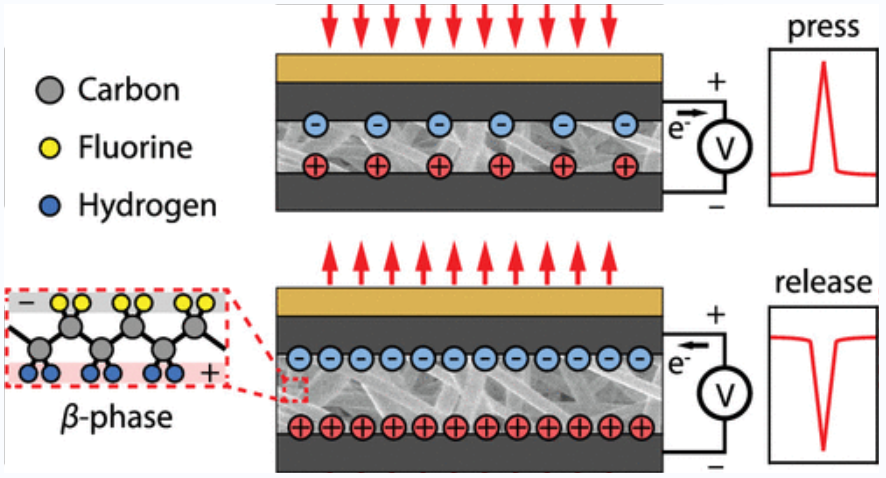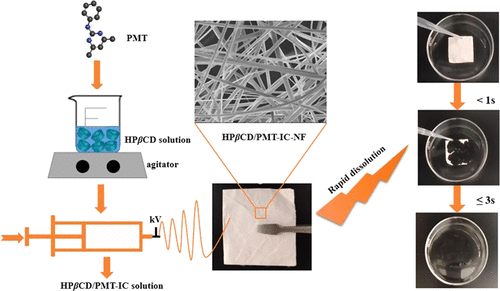Copyright © 2022 Foshan MBRT Nanofiberlabs Technology Co., Ltd All rights reserved.Site Map
Introduction:This paper sorts out five studies on electrospinning published in ACS Nano from April to June 2022, including applications in sensors, drug adsorption, agriculture, etc. these documents can be studied and exchanged for everyone, hoping to provide new ideas for scientific research.
1. Sun Peng team of the State Key Laboratory of Integrated Optoelectronics: all nanofiber network structure for ultra sensitive piezoresistive pressure sensors


▷ sensing materials with fiber structure are excellent candidates for making flexible pressure sensors because of their large specific surface area and abundant contact points.
▷ this sensor device has a multilayer nanofiber network structure prepared by simple electrospinning technology. The initial resistance can be effectively increased by using gold-plated PA6 fiber as the upper and lower flexible electrodes. Due to this special fiber electrode structure, the sensor can produce large electrical signal variability when subjected to weak external force. Devices with different sensing characteristics can be obtained by controlling the electrospinning time. The sensor based on pedot:pss/pa6 nanofiber network has high sensitivity (6554.6 kPa – 1 at 0 – 1.4 kPa), fast response time (53 MS) and wide detection range (0 – 60 kPa).
▷ it is worth noting that the device still maintains ultra-high sensitivity when it is loaded for more than 10000 cycles at 5 kPa, which makes it have broad application prospects in human health monitoring and sports monitoring.
DOI:doi.org/10.1021/acsami.1c24257
2. Jarred w. fastier woolle team, School of engineering and building environment, Griffith University, Australia: multimodal fiber static and dynamic tactile sensors


▷ a research team from Griffith University in Australia proposed a highly versatile, low-cost and robust tactile sensor that can obtain load measurements using poly (vinylidene fluoride Co trifluoroethylene) [p (VDF TrFE)] micro and nano fiber elements in static and dynamic modes.
▷ the sensor consists of three basic layers, a fiber core P (VDF TrFE) layer and two nickel / copper conductive fabric electrode layers, with a total thickness of less than 300 μ m。 The core fibers were deposited directly on the soft polydimethylsiloxane (PDMS) fingertips by in-situ electrospinning. The core layer is consistent with the surface without additional treatment, showing the ability of in-situ electrospinning manufacturing method. The tactile sensor shows stable and reliable static and instantaneous dynamic load measurement performance for 30000 test cycles in a total of 30 minutes.
▷ this article discusses and illustrates the ability and significance of the proposed multimodal tactile sensor design in robot tactile sensing applications.
DOI:doi.org/10.1021/acsami.2c08195
3. Professor Lu geyu and his team from the State Key Laboratory of Integrated Optoelectronics: nio/nife2o4 in tube composites prepared by electrospinning for rapid detection of triethylamine under different humidity


▷ design a high-performance triethylamine gas sensor with stable gas response and low resistance change in the range of relative humidity, which is expected to be used for human health and environmental monitoring.
▷ here, a novel porous nio/nife2o4 fiber tube nanostructure was prepared by electrospinning. The characterization related to microstructure and surface morphology was carried out. At the same time, the gas sensing properties of fiber nio/nife2o4 in porous pipe were systematically evaluated and compared. The results show that the introduction of NiO as the second component can not only reduce the baseline
resistance of NiFe2O4. This gas sensor greatly optimizes the gas sensing performance.
▷ in addition, the response becomes more stable, and the baseline resistance changes less in a wide range of relative humidity, showing excellent humidity resistance. These phenomena may be attributed to the unique fiber nanostructure in the tube and the heterostructure between NiFe2O4 and NiO.
DOI:doi.org/10.1021/acssensors.1c02462
4. Professor Pan Jianming and his team from Jiangsu University: borate affinity functionalized Zn MOF / PAN derived molecularly imprinted hollow carbon electrospun nanofibers for selective adsorption of shikimic acid


▷ electrospun micro / nano fibers with customized specific binding sites are popular because of their great potential in separation applications. In this work, combined borate affinity (TBA) functionalized molecularly imprinted hollow carbon electrospun nanofibers (MI hcesnfs) derived from zif-8/pan fibers were proposed, which have selective binding sites to shikimic acid (SA).
▷ each component used in this strategy performs its own duties: hcesnfs with excellent structural properties is used as a high porous electrospun substrate, KH560 is used as a grafting material for subsequent polyethyleneimine (PEI) modification, Pei is used as a dendritic platform to approach more boric acid, with its long chain rich in amino groups, and TBA molecular groups as functional monomers, which are specifically combined with SA under neutral conditions. Thanks to the porous structure, high-density boric acid and easily accessible imprinting sites on the surface, MI hcesnfs showed strong affinity and selectivity for SA molecules.
▷ in addition, this work proposes a new strategy for preparing borate affinity adsorbents based on electrospinning technology to capture SA, and provides a way for the integration of molecularly imprinted polymers and electrospinning
DOI:doi.org/10.1021/acsami.2c06664
5. Professor Fu Ying and his team from Northeast Agricultural University: antifungal hydroxypropyl based on electrospinning- β- Preparation and characterization of cyclodextrin / pyrimethanil inclusion complex nanofibers


▷ pyrimethanil (PMT) is an aniline pyrimidine fungicide. Its application is limited because of its poor water solubility.
▷ in order to improve the physical and chemical properties of PMT, the author prepared hydroxypropyl by electrospinning- β- Cyclodextrin / pyrimethanil inclusion complex nanofibers (HP β CD/PMT-IC-NFs)。 A variety of analytical techniques were used to confirm the formation of inclusion complexes. Scanning electron microscope image shows HP β Cd/pmt-ic-nf is uniform and free of particles. Thermogravimetric analysis showed that the formation of inclusion complexes improved the thermal stability of PMT.
▷ in addition, phase solubility tests showed that PMT and HP β The inclusion complex formed by CD has stronger water solubility. Antifungal test showed that HP β Cd/pmt-ic-nf has good antifungal properties. In short, prepare HP β Cd/pmt-ic-nf inhibits the improvement of the solubility and thermal stability of PMT, thus promoting the development of pesticides to water-based and low pollution.
DOI:doi.org/10.1021/acs.jafc.2c01866